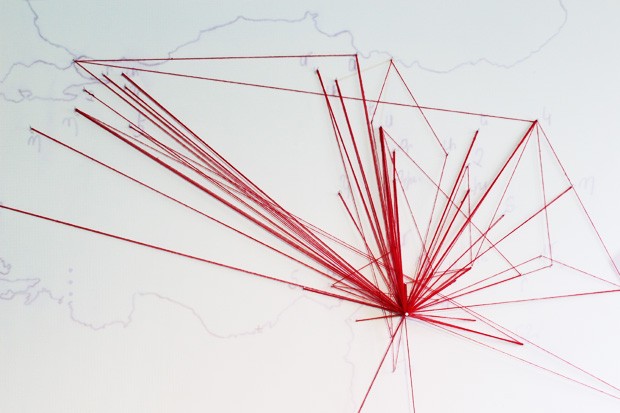How do you communicate marginalized histories of violence?
 A still of Hourig Attarian's installation “Threading a map, spinning life stories" (photo by Shahrzad Arshadi).
A still of Hourig Attarian's installation “Threading a map, spinning life stories" (photo by Shahrzad Arshadi).
Commemorating marginalized groups that have experienced violence, suffering or genocide can be a tricky business. Often, large-scale debates ensue about exclusions, inappropriate comparisons and what is often referred to as “hierarchies of suffering” or “victim competition.”
Recently, such concerns have swirled around the Canadian Museum for Human Rights as well as the proposed Memorial to the Victims of Communism.
Moving Memory: Difficult Histories in Dialogue is a new exhibition by postdoctoral fellow Nadine Blumer, being launched at Concordia on June 6 as part of the Association of Critical Heritage Studies Third Biennial Conference.
This innovative curatorial project — which Blumer developed with the help of her colleagues Hourig Attarian and Anique Vered — is an attempt to address the following questions: How do you create meaningful spaces for marginalized histories of suffering? And how do you communicate different histories of violence in a shared space?
We sat down with Blumer to learn more about the exhibition.
Tell us about your project.
Moving Memory is a collaborative research exhibition about the Armenian and Roma genocides that is made up of several installations and a live performance piece. It will take place in several physical and virtual locations.
We are concerned primarily with histories of suffering that are marginalized from the official record. We are also experimenting with ways of bringing together two separate cases of genocide in one shared project and space.
Our exhibit tackles these issues head-on, taking the lens of comparative genocide and experimenting with ways of respectfully communicating the complexities and singularities of individual cases of genocide while also highlighting important similarities, overlaps or interconnections.
The title, Moving Memory, is already a clue to one of our techniques: In this project we literally work to move memory by going beyond the gallery walls and also linking up physical and virtual space.
What drew you to this topic? What do you hope to uncover with your curatorial project?
Our objective — based on a combined total of over 15 years of fieldwork and archival research — is to experiment with new ways of thinking through how we talk about difficult histories. In particular, we are motivated to find effective and engaging ways of opening up discussions about marginalized histories of suffering.
We are experimenting with a wide range of multimedia tools and techniques that go beyond straightforward research output. So, rather than limiting ourselves to journal articles or book publications, we are creating a participatory and interactive exhibition that brings together academics as well as community participants.
What have been some of the challenges?
One is that we’re working not only across disciplines but also sectors. I’m a trained sociologist with no curating experience. My colleague Hourig is an education scholar who has many years of community outreach and research-creation behind her, and Anique is an artist-researcher, curator and community strategist.
As a result, we do not always speak the same academic language, but ultimately we are committed to learning from each other and gaining perspectives that we may have otherwise missed in our respective professional niches.
My supervisor, Erica Lehrer, has also been instrumental in helping us network across the university and connect with a wide variety of faculty engaged in innovative research-creation projects. Thanks to the SSHRC Connection Grant support we have for our project, we’ve been able to hire some incredible student talent, from Theatre Design and Computation Arts to Art History and Communication Studies.
What’s next?
We hope faculty and students will be inspired to think about how they might curate the fruits of their own research. We're eager to expand the community of users of the Curating and Public Scholarship Lab (CaPSL). Anyone interested can contact cerev@concordia.ca for more information.
Moving Memory: Difficult Histories in Dialogue launches Monday, June 6 from 1:30 to 3 p.m. in the Curating and Public Scholarship Lab (CaPSL), located in Room LB-671 of the J.W. McConnell Building. It runs daily (excluding weekends) from 10:30 a.m. to 4:30 p.m. until June 15.
Anique Vered’s “Public-Panel-Relay,” part of Moving Memory, takes place on Tuesday, June 7 from 1-2:30pm in the EV Atrium.


